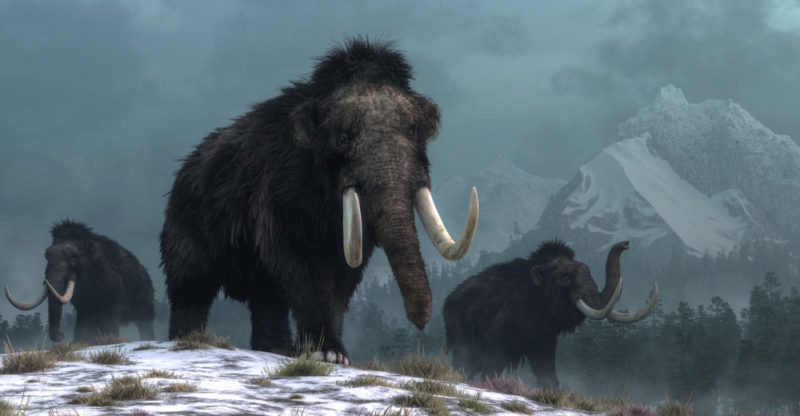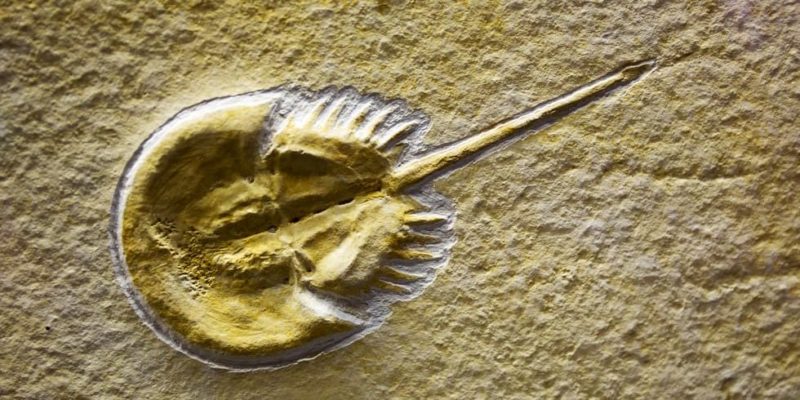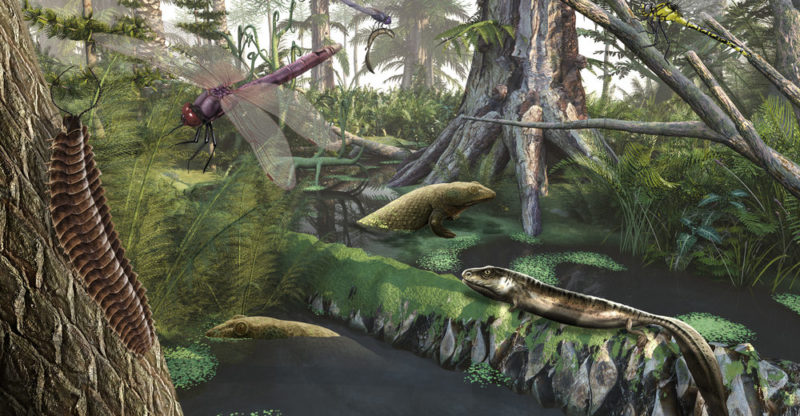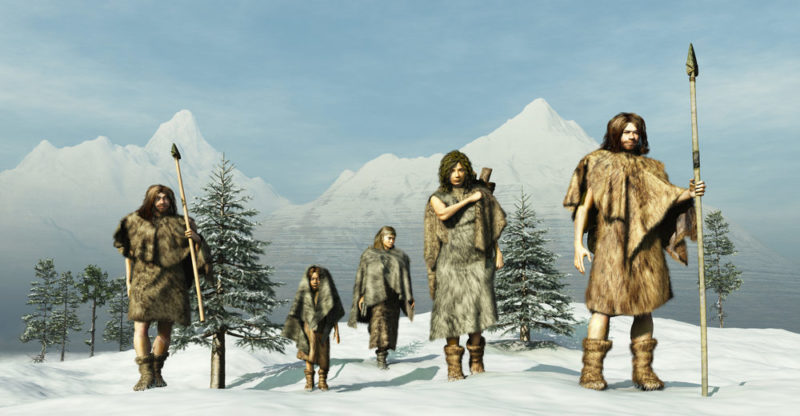We explain what geological eras are, the eons that group them and their periods. Also, what are its characteristics and importance.
What are geological ages?
Geological eras are a type of division of the geological time scale , that is, the scale used to measure the history of the planet and of life from its very beginning. It is one of the largest units of the scale, which can be found within each eon, that is, the eons are divided into geological eras.There are ten geological eras, throughout which the process of formation and transformation of the Earth began , as well as the emergence of life, its complexity, its diversification throughout the world and its evolution. Its most recent point is the appearance of human beings and the rise of our civilization.
the aeons
 The geological time scale represents all the time elapsed from the origin of the planet to the present.
The geological time scale represents all the time elapsed from the origin of the planet to the present.That huge span of time , estimated at just over 4.5 billion years , is divided into four large spans known as eons.
These are:
- Hadean Eon . Started about 4.5 billion years ago
- Archean Eon . It started around 4,000 million years ago
- Proterozoic Eon. Started about 2.5 billion years ago
- Phanerozoic Eon. It began approximately 541 million years ago and continues until today.
The first three aeons additionally informally make up a super-aeon known as the Precambrian .
These eons represent the great periods of Earth's history . Each one is divided into geological eras, smaller units of time, of variable number depending on the eon. These, in addition, can be divided into Periods, even shorter; and these in turn into Epochs. The Epochs in geological Ages, and the latter in Chronos or Chronozones.
Origin of the geological time scale
Also called the geologic time scale or the international chronostratigraphic table , it is a time frame of reference for chronologically ordering events in the history of the Earth and of life on it. For this, it is guided by the nature of the rocks and the continents , establishing divisions and periods.
It is based on their relative age and the overlapping layers of rocks and other materials that make up the soil . Transit from one layer to the next represents the equivalent of traveling backwards in time.
Previously , different scales were used depending on where the geologist came from , especially during the 19th century, when there were numerous discoveries on the subject , due to the boom in mineral exploitation in the world.
To overcome the differences, this scale was internationalized and unified from 1974 , thanks to the creation of the International Committee of Stratigraphy of the International Union of Geological Sciences. There is an approximate equivalent for other known stars, such as the Moon or Mars .
The geological ages of the Earth

So far there is talk of ten geological eras, distributed differently throughout the four eons of the geological time scale. These eras are:
- Hadean Eon. Does not contain geological eras.
- Archean Eon. Four geological eras:
- Eoarchaic. It starts about 4,000 million years ago.
- Paleoarchaic. It starts about 3.6 billion years ago.
- Mesoarchaic. It starts about 3.2 billion years ago.
- Neo archaic. It starts about 2.8 billion years ago.
- Proterozoic Eon. Three geological eras:
- Paleoproterozoic. It starts about 2.5 billion years ago.
- Mesoproterozoic. It starts about 1.6 billion years ago.
- Neoproterozoic. It starts about 1,000 million years ago.
- Phanerozoic Eon. Three great geological eras:
- Paleozoic. It starts about 541 million years ago.
- Mesozoic. It starts about 252 million years ago.
- Cenozoic. It starts about 66 million years ago.
Division of geological ages
Geological eras, in turn, are divided into periods. These are much more numerous and are the following:
- It was Eoarchaic. No periods or subdivisions.
- Paleoarchaic era. No periods or subdivisions.
- It was Mesoarchaic. No periods or subdivisions.
- Neo-Archaic era. No periods or subdivisions.
- Paleoproterozoic era. Four Periods:
- Sideric. Started about 2.5 billion years ago.
- Riacic. Started about 2.3 billion years ago.
- Orosiric. Started about 2,050 million years ago.
- Stateric. Started about 1.8 billion years ago.
- Mesoproterozoic era. Three periods:
- Calimic. Started about 1.6 billion years ago.
- ecstatic. Started about 1,400 million years ago.
- Sthenic. Started about 1,200 million years ago.
- Neoproterozoic era. Three periods:
- Tonic. Started about 1,000 million years ago.
- Cryogenic. Started about 850 million years ago.
- Ediacaran. Started about 635 million years ago.
- Paleozoic era . Six periods:
- Cambrian. Started about 541 million years ago.
- Ordovician. Started about 485 million years ago.
- Silurian. Started about 443 million years ago.
- Devonian. Started about 419 million years ago.
- Carboniferous . Started about 385 million years ago.
- Permian . Started about 298 million years ago.
- Mesozoic era . Three periods:
- Triassic . Started about 252 million years ago.
- Jurassic . Started about 201 million years ago.
- Cretaceous . Started about 145 million years ago.
- Cenozoic era . Three periods:
- Paleogene . Started about 66 million years ago.
- Neogene. Started about 23 million years ago.
- Quaternary . Started about 2.5 million years ago.
Importance of geological eras
 The classification of geological time in Eras, on the one hand, allows the rocks, stones and fossils found in paleontological excavations to be named and ordered based on clear criteria . The context in which they were found is used as an indication of when the rock was formed or transformed, or when the creature would have been alive.
The classification of geological time in Eras, on the one hand, allows the rocks, stones and fossils found in paleontological excavations to be named and ordered based on clear criteria . The context in which they were found is used as an indication of when the rock was formed or transformed, or when the creature would have been alive.Secondly, these studies provide more and better information regarding the past stages of our planet and the conditions in which life was formed, as well as the changes that it must have gone through in order to reach today.
Major geological eras
 The geological eras of the Phanerozoic Eon were the first to be identified and formulated, by the pioneers of 19th century geology , such as the British Charles Lyell.
The geological eras of the Phanerozoic Eon were the first to be identified and formulated, by the pioneers of 19th century geology , such as the British Charles Lyell.Initially, the first identified Eras were called Primary, Secondary and Tertiary , but soon they were called Paleozoic, Mesozoic and Cenozoic, understood respectively as "Ancient Fauna" or "Age of invertebrates ", "Middle Fauna" or "Age of reptiles ". ” and “New Fauna” or “Age of Mammals ”.
Ages of the Archean Eon
The Hadean Eon can hardly be investigated, since it encompasses the formation of the planet . The next most remote is the Archean Eon, and due to its antiquity, the study of its respective four Ages is difficult and demanding.Rocks have gone through many changes and transformations throughout 4,000 million years of history. The eventual fossils of the microbial life that arose in this period hardly left any recognizable traces.
In these Eras, therefore, the slow cooling of the Earth occurred to levels that allowed the emergence of life in the first oceans . The atmosphere was very different from the one we know today: ammonia and methane were abundant in it.
However, photosynthesis began towards the end of the last era . That gave rise, over the next eon, to the Great Oxygenation Event of the atmosphere .
Eras of the Proterozoic Eon
 Throughout these three eras , oxygen was abundant thanks to photosynthesis . Along with the cooling of the planet, it allowed the development of more complex forms of life.
Throughout these three eras , oxygen was abundant thanks to photosynthesis . Along with the cooling of the planet, it allowed the development of more complex forms of life.Initially they were eukaryotic cells but soon the first forms of multicellular life (metazoans) arose, at least in the seas . The continents had already formed and their dispersion and reunion had begun, forming various supercontinents throughout history, the last of which was Pangea.
Climate changes became more evident in the Neoproterozoic Era, when the first ice age in the planet's history occurred (in the Cryogenic). On the other hand, it allowed the conquest of the Earth by the first forms of plant life .
Eras of the Phanerozoic Eon
In these last three stages , the world as we know it was shaped . Initially the Earth was conquered by the first amphibian and later reptilian life forms.This gave way to new evolutionary dynamics that resisted the great mass extinctions , especially those of the Permian-Triassic (more than 90% of extinct life) and the Cretaceous-Paleogene (around 75% of extinct life).
The Mesozoic was the Age of the dinosaurs , in which they flourished, prospered, diversified, and finally became extinct, leaving only birds and small mammals as witnesses.
These life forms claimed the world as their own in the Cenozoic , when the supercontinent Pangaea broke up. Life flourished again in a version more similar to how we understand it today.
Appearance of the Human Being
 The first ancestors of the human being arose in the Cenozoic Era , towards the end of the Neogene period and the beginning of the Quaternary, in the middle of the Ice Age . At the end of the latter, the struggle between the various hominin species culminated in the arrival of Homo sapiens .
The first ancestors of the human being arose in the Cenozoic Era , towards the end of the Neogene period and the beginning of the Quaternary, in the middle of the Ice Age . At the end of the latter, the struggle between the various hominin species culminated in the arrival of Homo sapiens .Human civilization began when this species later discovered agriculture and abandoned nomadic life .
The above content published at Collaborative Research Group is for informational and educational purposes only and has been developed by referring reliable sources and recommendations from technology experts. We do not have any contact with official entities nor do we intend to replace the information that they emit.
Abubakr Conner brings a diverse skill set to our team, and covers everything from analysis to the culture of food and drink. He Believes: "Education is the most powerful weapon that exists to change the world." .
Leave a reply
Your email address will not be published. Required fields are marked *Recent post

Sport: What Is It, Types, Risks, Features, Characteristics and Examples

Dogs: Emergence, Features, Characteristics, Feeding and Breeds

Story: Definition, Elements, Structure, Features and Characteristics

